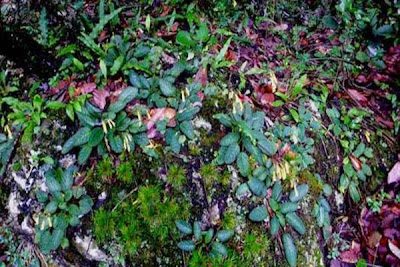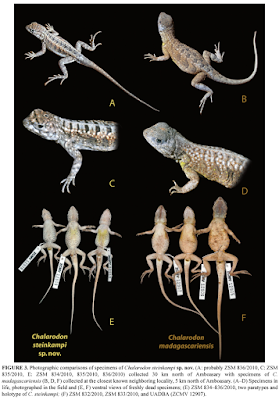![]() |
Fig. 3: Chayamaritia banksiae D.J.Middleton.b Close-up of flower showing strongly imbricate sepals; c Close-up of corolla throat and stigma.
Chayamaritia smitinandii (B.L.Burtt) D.J.Middleton. d Fruiting population of Middleton et al. 5632. e Flowering plant of Middleton et al. 5652.
|
Abstract Based on a phylogenetic analysis of Asian Gesneriaceae with the most comprehensive coverage at the genus level to date, the new genus Chayamaritiais established and described in subfamily Didymocarpoideae, tribe Trichosporeae, subtribe Didymocarpinae. It contains two species, of which one, Chayamaritia smitinandii (B.L.Burtt) D.J.Middleton, was formerly placed in the genera Chirita and Henckelia. The other,Chayamaritia banksiaeD.J.Middleton, is newly described. The exclusion of Chayamaritia smitinandii from Henckelia further clarifies the taxonomic and biogeographic limits of Henckelia following its considerable recircumscription during the recent remodelling and synonymisation of Chirita.
Keywords: Biogeography, Chayamaritia, Gesneriaceae, New genus, Molecular phylogeny, Southeast Asia
Chayamaritia D.J.Middleton & Mich.Möller, gen. nov.
— TYPE: Chayamaritia smitinandii (B.L.Burtt) D.J.Middleton.
Diagnosis: Similar to both
Henckelia and
Primulina in the tubular corollas, two fertile stamens and chiritoid stigma but differing from both in the combination of thickened rhizomatous prostrate stem, the alternately arranged leaves and the imbricate sepals.
Distribution: Central and eastern Thailand, Laos.
Etymology: The genus is named in honour of Dr
Kongkanda Chayamarit of the Forest Herbarium in Bangkok. She has been a tireless advocate of research on the Thai flora and has been instrumental in the increase in publication rate of the Flora of Thailand series in recent years. She has done this through finding sources of funding for field work and family accounts and through ensuring that authors of accounts do not forget their promises! Currently only known from two species, one of them newly described here.
Key to the species in Chayamaritia1. Calyx lobes 7–15 mm wide; corolla tube whitish ventrally, lobe margins dentate; leaves 1.5–1.9 times as long as wide, base rounded to subcordate ……………
C. banksiae.
1. Calyx lobes 0.9–4.2 mm wide; corolla tube purple ventrally, lobe margins more or less entire; leaves 1.8–5.6 times as long as wide, base cuneate to attenuate or rarely rounded ……………
C. smitinandii.
![]() |
Fig. 3: Chayamaritia banksiae D.J.Middleton. a Whole plant in cultivation at the Royal Botanic Garden Edinburgh; b Close-up of flower showing strongly imbricate sepals; c Close-up of corolla throat and stigma. Chayamaritia smitinandii (B.L.Burtt) D.J.Middleton. d Fruiting population of Middleton et al. 5632. e Flowering plant of Middleton et al. 5652.
|
Chayamaritia banksiaeD.J.Middleton, sp. nov.
— TYPE: Laos, Khammouan, Nam On catchment, Phou Ak escarpment, Nakai Nam Theun NBCA, 936 m a. s. l.
Distribution: Endemic to Laos (Khammouan Province). Habitat: Growing on sides of boulders in evergreen forest.
Etymology: Named after the botanical illustrator Claire Banks.
Proposed IUCN conservation assessment: Data Deficient.
Chayamaritia banksiae is only known from one collection, and its complete distribution is unknown. The type specimen was collected from a cultivated plant with known provenance in Nakai Nam Theun National Biodiversity Conservation Area in Khammouan Province in Laos. Although the collection locality is not particularly far from the populations of
Chayamaritia smitinandii in northeastern Thailand, the two species are easily distinguished, most obviously in leaf and sepal shapes as noted in the key and diagnosis.
Chayamaritia smitinandii (B.L.Burtt) D.J.Middleton, comb. nov.
—TYPE: Thailand, Nakhon Ratchasima, Khao Yai National Park, 6 Oct 1962, T. Smitinand 7491 (Holotype BKF) (Figs. 3c, d, 4)
:
Chirita smitinandii B.L.Burtt in
Thai Forest Bull., Bot. 29: 89. 2001
:
Henckelia smitinandii (B.L.Burtt) D.J.Middleton & Mich.Möller,
Taxon. 60: 776. 2011.
Distribution: Thailand (Nakhon Ratchasima, Nakhon Nayok, Buengkan and Nakhon Phanom Provinces). Habitat: In evergreen and submontane forest in deep shade at 150–1200 m altitude.
Etymology: Named after the Thai botanist
Tem Smitinand(1920–1995) who was also a maternal uncle of Kongkanda Chayamarit after whom the genus is named.
Proposed IUCN conservation assessment: Vulnerable
VU B1 ab(iii). This species has an Extent of Occurrence of less than 20,000 sq.km., and the northeastern populations are widely separated from the central populations by the predominant agricultural landscape of northeastern Thailand. In addition, the known populations can be subject to disturbance by the high visitor numbers found in the areas where this species is found in Khao Yai National Park.
David J. Middleton, Kanae Nishii, Carmen Puglisi, Laura L. Forrest and Michael Möller. 2015. Chayamaritia (Gesneriaceae: Didymocarpoideae), A New Genus from Southeast Asia.
_pulcher-novataxa_2015-Lukhaup_lg.jpg)




















































